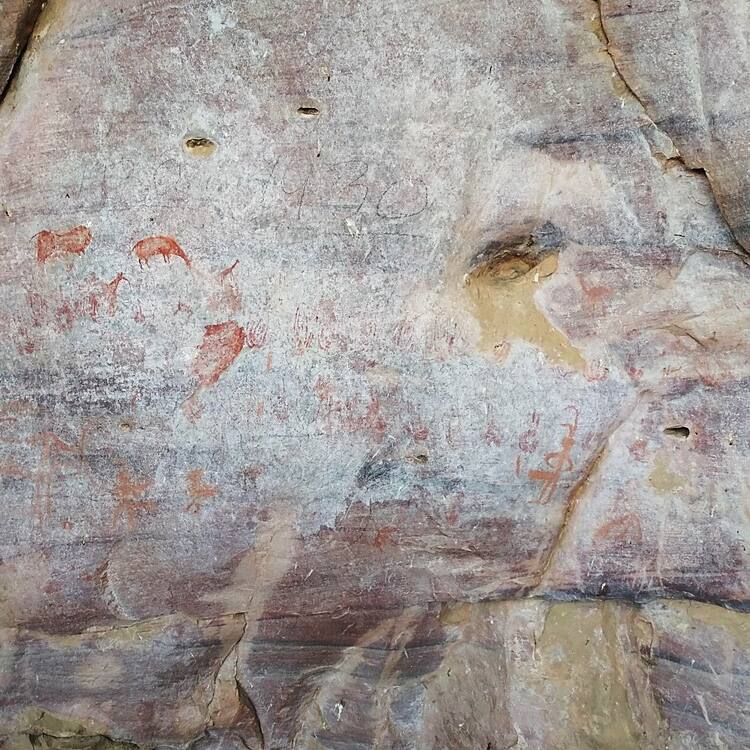The Emergence of Modern Human Behaviour: The Pleistocene Occupation Sites of South Africa
The Emergence of Modern Human Behaviour: The Pleistocene Occupation Sites of South Africa
This serial property contributes to the understanding of the origin of behaviourally modern humans, their cognitive abilities and cultures, and the climatic transitions that they survived. It is composed of three dispersed archaeological sites, Diepkloof Rock Shelter, Pinnacle Point Site Complex, and Sibhudu Cave, located in the Western Cape and KwaZulu-Natal provinces of South Africa. These sites provide the most varied and best-preserved record known of the development of modern human behaviour, reaching back as far as 162,000 years. Symbolic thought and advanced technologies are exemplified by evidence of ochre processing, engraved patterns, decorative beads, decorated eggshells, advanced projectile weapons and techniques for toolmaking, and microliths.
Description is available under license CC-BY-SA IGO 3.0
L’émergence du comportement humain moderne : les sites d’occupation du Pléistocène en Afrique du Sud
Ce bien en série contribue à la compréhension de l’origine des humains modernes sur le plan comportemental, de leurs capacités cognitives et de leurs cultures, ainsi que des transitions climatiques auxquelles ils ont survécu. Il est constitué de trois sites archéologiques dispersés : l’abri-sous-roche de Diepkloof, l’ensemble de sites de Pinnacle Point et la grotte de Sibhudu, situés dans les provinces du Cap-Occidental et du KwaZulu-Natal en Afrique du Sud. Ces sites fournissent les témoignages connus les plus variés et les mieux préservés sur l’évolution du comportement humain moderne, remontant jusqu’à 162 000 ans. La pensée symbolique et des technologies avancées sont illustrées par des traces de traitement de l’ocre, des motifs gravés, des perles d’apparat, des coquilles d’œufs décorées, des armes à projectiles perfectionnées, ainsi que des techniques de fabrication d’outils et des microlithes.
Description is available under license CC-BY-SA IGO 3.0
ظهور السلوك البشري الحديث: مستوطنات العصر الحديث الأقرب في جنوب أفريقيا
يساهم هذا الموقع المتسلسل في فهم أصل البشر المعاصرين والحداثة السلوكية، فضلاً عن مهاراتهم الإدراكية وثقافاتهم والتحولات المناخية التي صمدوا في وجهها. ويضم الموقع ثلاثة مواقع أثرية موزعة في محافظتي كيب الغربية وكوازولو ناتال في جنوب أفريقيا، وهذه المواقع هي: ملجأ دِيپْكلووف الصخري، ومجمع موقع بيناكل بوينت، وكهف سِيبْهودو، وهي تكتنز واحداً من السجلات المعروفة التي تمتاز بأعلى درجات التنوع وحوفظ عليها على أفضل وجه لتقف شاهداً على تطور السلوك البشري الحديث، ويعود تاريخها إلى 162 ألف عام مضى. ويُعتبر عملية معالجة حجر المغرة، والزخارف المنقوشة، والخرز المزخرف، وقشر البيض المزين، وأسلحة القذف المتقدمة، وتقنيات صناعة الأدوات، وأدوات الميكروليث الحجرية، دليلاً على التفكير الرمزي والتكنولوجيا المتقدمة.
source: UNESCO/CPE
Description is available under license CC-BY-SA IGO 3.0
现代人的出现:南非更新世人类遗址
南非更新世人类遗址系列遗产有助于我们了解行为现代性人类的起源,其认知能力、文化及其所经历的气候变化。遗产由分布在南非西开普省和夸祖鲁—纳塔尔省的3处考古遗址组成:迪普克鲁夫(Diepkloof)岩棚、品尼高点(Pinnacle Point)遗址群和西布杜(Sibhudu)洞穴。它们为现代人类行为的发展历程提供了种类最丰富、保存最完好的记录,最早可追溯至16.2万年前。赭石加工、雕刻图案、装饰珠、装饰蛋壳、先进的弹射武器和工具制造技术以及细石器,都是当时象征思维和先进技术的例证。
source: UNESCO/CPE
Description is available under license CC-BY-SA IGO 3.0
Возникновение поведения людей современного типа: поселения плейстоценовой эпохи в Южной Африке
Этот серийный объект позволяет составить представление о происхождении людей современного типа, их когнитивных способностях и культуре, а также о климатических изменениях, которые они пережили. Он состоит из трех отдельных археологических объектов: скалистой пещеры Дипклоф, комплекса стоянок Пиннакл Пойнт и пещеры Сибуду. Объекты расположены в Западно-Капской провинции и провинции Квазулу-Натал в Южной Африке. В этих местах находятся наиболее разнообразные и хорошо сохранившиеся свидетельства развития поведения человека современного типа, возраст которых достигает 162 000 лет. Примерами символического мышления и передовых технологий служат предметы обработки охры, гравированные узоры, декоративные бусы, инкрустированная яичная скорлупа, усовершенствованное метательное оружие и техника изготовления орудий труда, а также микролиты.
source: UNESCO/CPE
Description is available under license CC-BY-SA IGO 3.0
La aparición del comportamiento humano moderno: los sitios de ocupación del Pleistoceno en Sudáfrica
Este sitio en serie contribuye a la comprensión del origen de los humanos modernos desde un punto de vista del comportamiento, sus habilidades cognitivas y culturas, así como las transiciones climáticas que sobrevivieron. Se compone de tres yacimientos arqueológicos dispersos, Diepkloof Rock Shelter, Pinnacle Point Site Complex y Sibhudu Cave, situados en las provincias sudafricanas de Cabo Occidental y KwaZulu-Natal. Estos sitios proporcionan el registro más variado y mejor conservado del desarrollo del comportamiento humano moderno, que se remonta hasta 162 000 años atrás. El pensamiento simbólico y las tecnologías avanzadas quedan evidenciados por el procesamiento de ocre, patrones grabados, cuentas decorativas, cáscaras de huevo decoradas, armas avanzadas y técnicas para la fabricación de herramientas y microlitos.
source: UNESCO/CPE
Description is available under license CC-BY-SA IGO 3.0
Outstanding Universal Value
Brief synthesis
Diepkloof Rock Shelter, Pinnacle Point Site Complex, and Sibhudu Cave are three widely dispersed archaeological sites located in the Western Cape and KwaZulu-Natal provinces of South Africa. Two of them, Sibhudu Cave and Diepkloof Rock Shelter, are located about ten kilometres from the current shoreline, while the Pinnacle Point Site Complex is located directly on the coast. These sites provide the most varied and best-preserved record known of the development of modern human behaviour, reaching back as far as 162,000 years. Symbolic thought and advanced technologies are exemplified by evidence of ochre processing, engraved patterns on ochre and bone, estuarine shellfish beads for body decoration, decorated ostrich eggshells, lithic technologies for advanced projectile weapons, heat treatment of stone for toolmaking, and microliths. This serial property contributes to the understanding of the origin of behaviourally modern humans, their cognitive abilities and cultures, and the climatic transitions that they survived.
Criterion (iii): The archaeological layers at the Diepkloof Rock Shelter, Pinnacle Point Site Complex, and Sibhudu Cave provide exceptional evidence of behavioural and palaeoenvironmental developments in the Middle Stone Age. They contain early evidence of symbolic thought and advanced technologies. The great variety of materials, the early dates, and the excellent state of conservation make the evidence of this important step in human development exceptional.
Criterion (iv): Diepkloof Rock Shelter, Pinnacle Point Site Complex, and Sibhudu Cave preserve exceptionally well-stratified and well-dated sedimentary records of ancient human life dating from about 162,000 to 38,000 years ago. The development of modern human behaviour and complex cognition are illustrated by the evidence of abstract thinking, the ability to plan and strategize, and technological innovation, including, for example, the preparation and use of adhesives and the heat treatment of lithic materials.
Criterion (v): Diepkloof Rock Shelter, Pinnacle Point Site Complex, and Sibhudu Cave offer some of the most important evidence known for the consistent exploitation of coastal resources during the Middle and Late Pleistocene. As current sea levels rise due to climate change, much of the ancient record of human coastal resource use has been obliterated or is in grave danger. As such, the excellent state of conservation of these rare sites is pivotal for preserving evidence of palaeoclimates and palaeoenvironments.
Integrity
The property includes all the attributes necessary to express its Outstanding Universal Value, and is of adequate size to ensure the complete representation of the features that convey its significance. All three component parts contain long stratigraphic sequences of human occupation that together cover a time span of about 124,000 years, from 162,000 to 38,000 years ago. Preservation conditions, even for organic material at the Sibhudu Cave, are very good. Favourable depositional processes have allowed the steady accumulation of archaeologically significant deposits with little or no loss due to natural erosion or human or animal activities. The views from the sites are generally undisturbed. Archaeological excavations have been conducted according to the highest international standards. All remains have been carefully curated and catalogued in national collections, and their significance and the interpretations based upon them have been reported and published in international journals.
Authenticity
The cultural values of the property are truthfully and credibly expressed through its attributes. The stratigraphic sequences and the dating of the different deposits, as excavated and documented by several international multidisciplinary teams of experts and peer reviewed at the time of publication, confirm the authenticity of the archaeological contexts and remains that constitute evidence of modern human behaviour.
Protection and management requirements
Legal protection of the property is based principally on the World Heritage Convention Act, No. 49 of 1999, and the National Heritage Resources Act, No. 25 of 1999, which protect the three component parts and provide for a system of Heritage Impact Assessment. The National Environmental Management Act, No. 107 of 1998, also includes a system of impact assessment.
The management of the Western Cape component parts is coordinated and hosted at the provincial level by the Member (minister) of the Executive Council of Cultural Affairs and Sport, and the management of the KwaZulu-Natal component part is coordinated and hosted by the KwaZulu-Natal Amafa and Research Institute. The two authorities will jointly serve as the overall Management Authority through the establishment of a Joint Management Committee. Each component part will have a Site Management Committee based in the local context. The World Heritage Convention Committee of South Africa advises on issues related to properties inscribed on the World Heritage List. Integrated Conservation Management Plans have been developed, as is required under the World Heritage Convention Act of the State Party. Stakeholders and the local communities are well integrated in the management process. The component parts are privately owned, which makes the formalisation of relationships with the legal owners through heritage agreements an important step to be completed as soon as possible.


